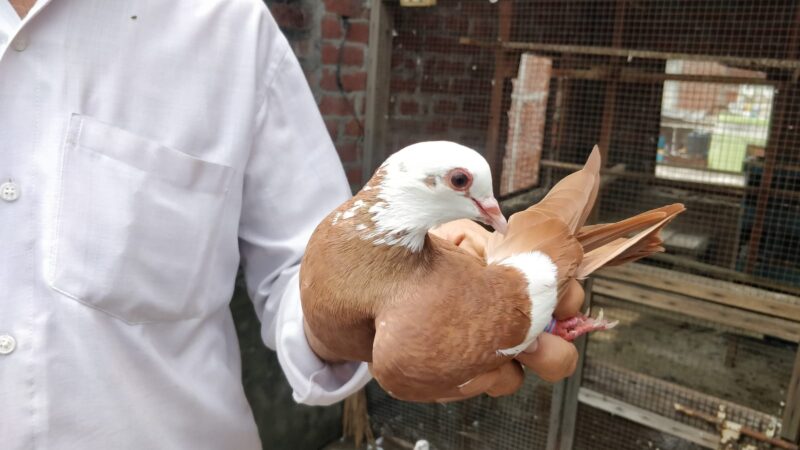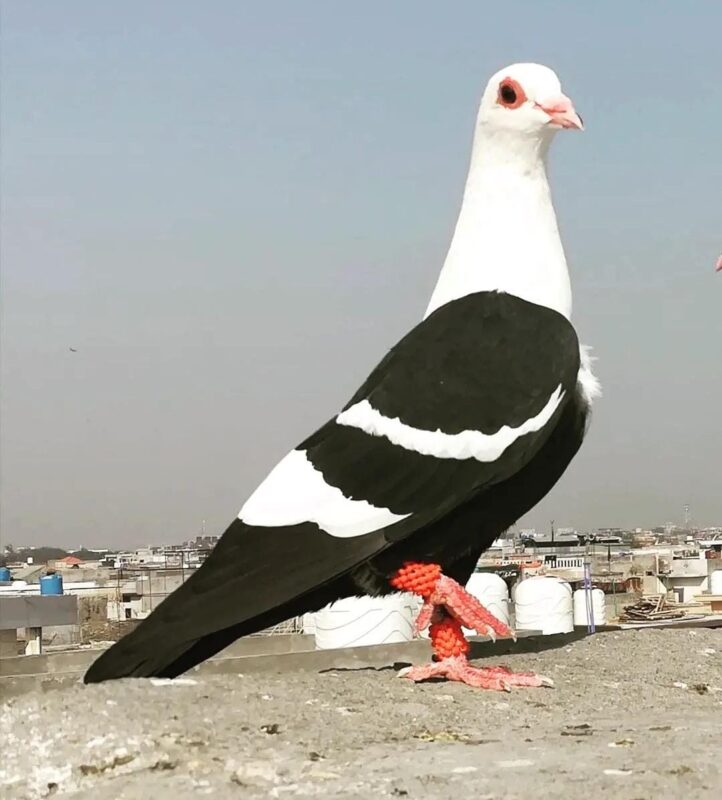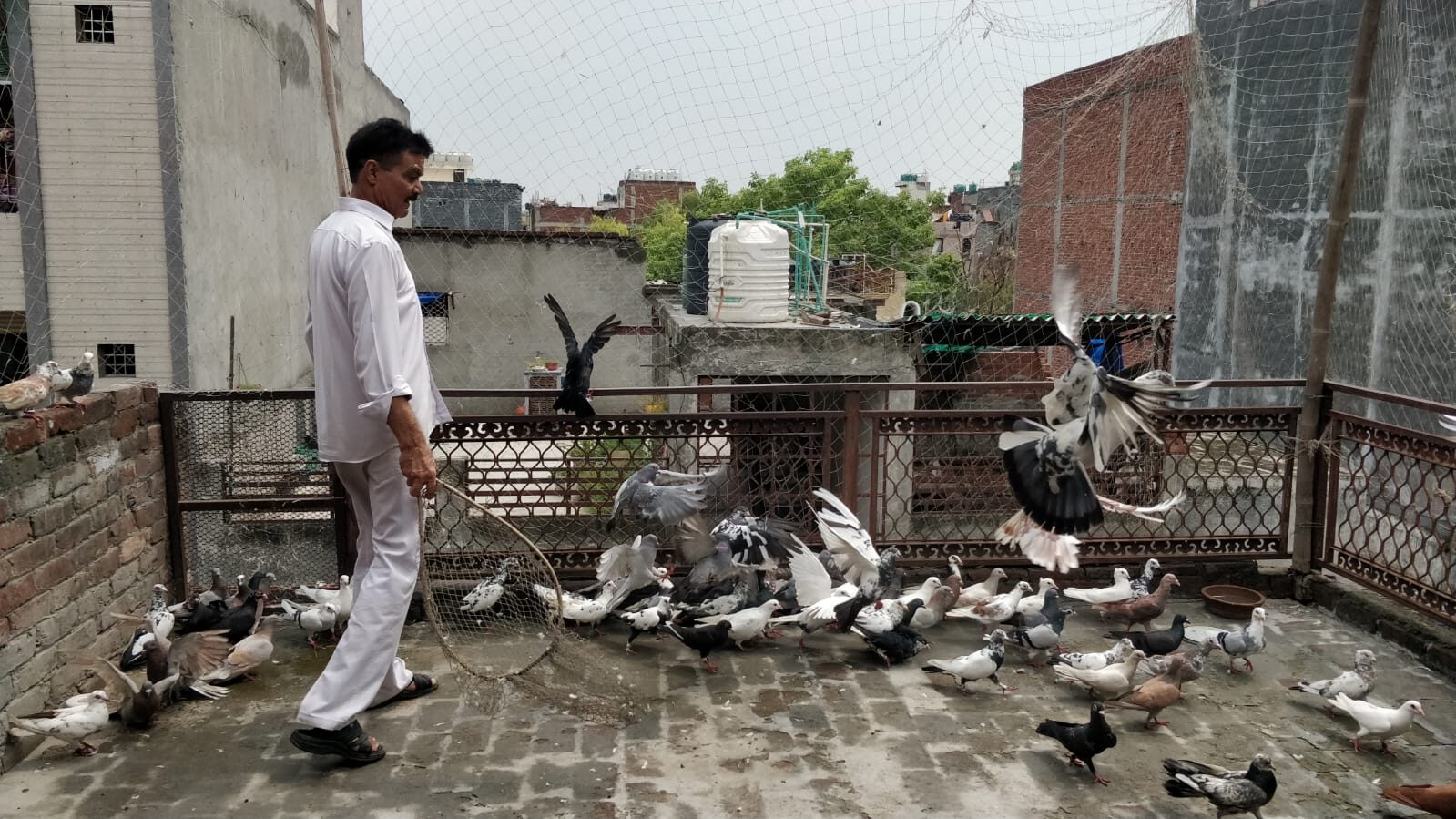In the crowded, narrow lanes of Kinari Bazaar, a beautiful spectacle awaits as one ascends the dusty stairs of a busy market. A few men are serving food to countless pigeons on the rooftop. There are compartments for different kinds of pigeons — some of them exquisitely white, some grey, while others are brown and ivory-coloured.
“You should be careful if you click a picture, lest they get scared”, says the caretaker. “They are very sensitive.”
The caretaker, who is looking after the pigeons in his father’s absence, is the son of Anil Sood, a famous kabootarbaz of old Delhi.
Kabootarbaazi is a folk sport popularized during the Mughal period in the subcontinent. While it may seem like an everyday hobby to the uninitiated, there is an elaborate hierarchy and rules peculiar to the community. On the top are the most experienced and respected – called Ustads, followed by Khalifas whose role is to assist Ustads and supervise Shagirds, the beginners.
“There are hundreds of years of ‘confidential nuskhe’ (remedies) that old ustads gave us that still continue”, says Sajid Anwar, a 54-year-old kabootarbaz in Seelampur who has been in the business for almost 30 years. In every part of the city, there are several ustads – crowned in a ceremony by a pagdi (turban) on the consensus that they have tajurba (experience) and bharosa (trust) – who pass on the knowledge of the sport to their followers.
“Everything is trust. If I don’t trust my ustad, I will find another one”, Anwar remarks. Usually, an ustad is assigned to look after the rooftops of his shagirds and khalifas. “In our language, we call it taleem, which means the number of students an ustad has. For example, if the ustad has ten students, all the rooftops belonging to the students will be supervised by their ustads. In this way, they will share their expertise directly or through their khalifas”, he explains.

Anwar’s day begins on the rooftop where he feeds his pigeons first. For him, it is a junoon (passion) without which he feels incomplete. He shares that he built three more storeys on his house so that he could continue his passion. “We only had a two-storey house and I could not see my pigeons in the sky when high apartments began to flourish. I collected money with time and built three new floors so that I could look after my pigeons”, he says. He has named all of his 140 pigeons – a lot of them repeating themselves.
It relaxes him to talk to his pigeons who understand every ishara (gesture) he makes. “They understand everything. If I tell my pigeons to sit, they will sit. If I ask them to fly far into the sky, they do it”, he says dreamily. Anwar prides himself that he can recognize his pigeons from miles away – an innate quality that every kabootarbaaz develops. “I understand their every harkat (action)”, he adds.
Asked if he ever thinks of selling them, he says, “Will you ever sell your children? Even if they are ill, it feels as if my child is ill. So selling them is out of the question for me.”
For Mohammad Asif too, a 22-year-old professional in Jafrabad, his pigeons are like his children. “Even if I go out of the city for a few days, they are always on my mind”, he says. Asif has been a part of the community for the last seven years. He developed an interest while observing his uncle’s dedication to the sport. He claims to know the whereabouts of his pigeons even when he is out in the city. “Everyone in the community knows how dear they are to us. So munshi ji or other kabootarbaz keep me updated on where my pigeons are”, he explains.
A munshi serves as a jury in tournaments and shares feedback wherever possible. He can be an ustad or a khalifa or somebody whose opinions on the matter are taken into account. Every year, a number of tournaments are held in Delhi — local or city-level — and the usual prize can be between Rs 1000 – Rs 50,000. There are local tournaments where there is no prize at all and are usually organized for the sole purpose of entertainment followed by some mithai.

As the scorching heat engulfs the city in summers, the most active time for the community begins in January and ends in March. “Right now, there is no point in troubling the pigeons. Humans cannot bear this heat, how can innocent creatures like them do?”, Asif remarks. Apart from the heat, Chinese manjha (string) and predatory birds remain two common threats for the pigeons.
A lot of consideration is taken into their khaan-paan (food intake). Despite the usual food such as chana, bajra, peeli moong, jau, sarso, makka, there is one special ‘feed’ for winters: chiknau, a mixture of desi ghee, almonds, cashews, akarkara and other ‘secretive ingredients.’ “We try to feed them the best we can. If they have eaten properly, I have eaten properly”, says Asif.
He predominantly pets Patiala pigeons. Speaking on the many nasl (breeds) of pigeons, he says, “There are Hyderabadi, Lucknowi, surkhe, lalband, humar, basra, resar and many others.” According to Anwar, Patiala pigeons have more stamina and are often used for tournaments. However, he says, it all depends on their food intake. “Each of them has its unique speciality”, he says.
VC Jain, an independent social worker, visits Delhi Gate everyday to feed the pigeons near Asif Ali statue. “They are tongue-less birds who need love and care”, he says. “It gives me a lot of satisfaction to feed them. If they get ill, I take them to a nearby hospital for treatment”, he adds. He has been doing this for many years and buys the best food for the pigeons from the shops lined up behind the statue.

Jain is against kabootarbazi on the grounds that it is cruel to the creatures. When Patriot asked about the claim, Anwar said, “I agree that there are some people who can be cruel as they treat it as a business only. However, this is not a practice at large since each of us treats them like our own” – something which Asif and other kabootarbaz affirmed.
For more stories that cover the ongoings of Delhi NCR, follow us on:
Instagram: https://www.instagram.com/thepatriot_in/
Twitter: https://twitter.com/Patriot_Delhi
Facebook: https://www.facebook.com/Thepatriotnewsindia





